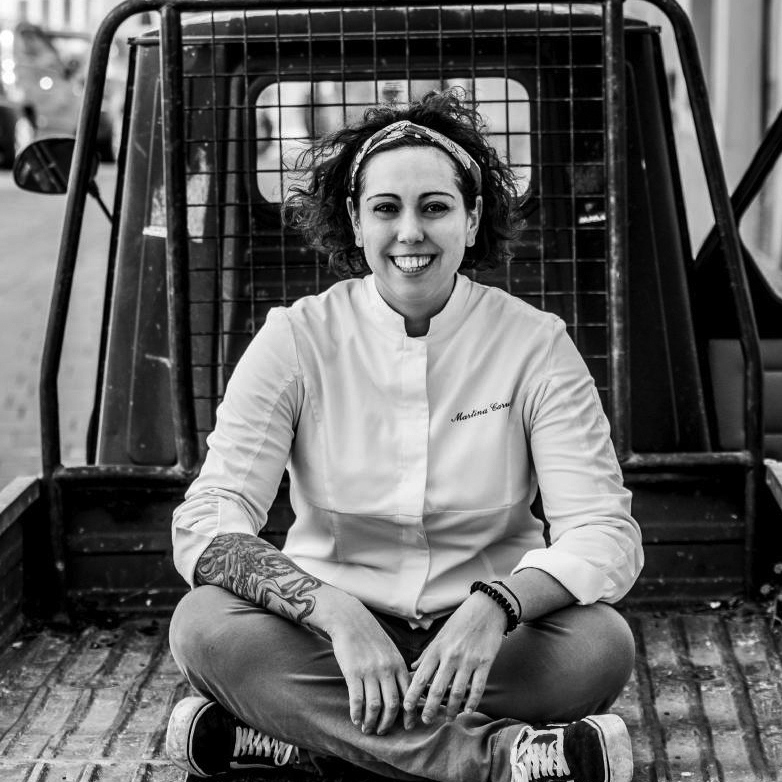A few years ago, Martina Caruso tasted the famous black-truffle ice cream at chef Ciccio Sultano’s Duomo, a two-Michelin-starred restaurant in Ragusa, a hilltop city in southeastern Sicily. At the time, in her 20s, Caruso was working in the kitchen at her family’s restaurant on the island of Salina, in the Aeolian archipelago off the northeastern Sicilian coast, but she did not wilt in the presence of the grand master of her region’s cuisine. Instead, as she recalled at a recent food festival on the JW Marriott’s private island in Venice, she asked herself: “Why can’t I make a really inventive and surprising ice-cream flavor?”
Now 29 years old, Caruso has already been named Italy Woman Chef of the Year by the 2019 Michelin guide. At 26, she became the youngest Italian to win a Michelin star for her cuisine at her family’s restaurant, which is located at the Hotel Signum, an upscale boutique hotel with panoramic views over Salina that has all the trappings—walking distance from a pebble beach, scented gardens, and a spa with thermal, healing waters that riffs on the ancient Greeks, former inhabitants of Salina—to become one of those resorts with a cult following around the world.
The Raw Ingredients
Caruso’s father, Michele, tried to dissuade his daughter from becoming a chef because of the profession’s unrelenting lifestyle—but with moxie and chutzpah, Caruso has become one the fastest-rising culinary stars of her generation. “Traditionally,” she says, “women chefs in Italy are in pastry, but when I turned 22, my father saw [cooking] was my passion and told me, ‘The cuisine is yours. You are ready to do this alone.’”
Caruso has not tried to re-invent Southern Italian cuisine, which requires little improvement. Instead, she has hewed to the region’s traditions and food heritage. Recently, she learned how to preserve fish from the local women on Alicudi, a small Aeolian island that didn’t have electricity until the 1990s. “You keep it in salt, and it will keep until the next season, and you can use it in soup and pasta,” says Caruso. “I love learning from the older generation.” Before she was of the legal drinking age, Caruso worked at top restaurants throughout the world, including the Michelin-starred Malabar in Peru, as well as in London with Jamie Oliver and in California with David Kinch.

Despite her tattoos—drawings of spaghetti aglio e olio and an octopus adorn one of her arms—Caruso does not entirely fit the prototype of a Gen Y foodie. She innovates with her cuisine without going excessively deconstructed or foamy. “You have to be serious but fun in your service and food,” she said about her general philosophy of cooking (and life). Ascribing to the ethos of environmental sustainability, Caruso’s restaurant is focused on minimizing kitchen waste; the liver and the bones of fish are used to flavor sauces. She’s concerned about over-fishing and has engaged the community on Salina about creating areas to protect fisheries.
One sunny morning at the Gather Food & Wine festival in Venice, Caruso was coating her tilefish in an almond crust. Once perfected, she moved on to her spaghetti aglio e olio—a deceptively simple combination of pasta, olive oil, garlic, and pepper flakes, but which Caruso elevates by using fish stock in the sauce, cooking the garlic down for an hour to make it less pungent, and topping it with garlic-bread crumbs. (Her pasta mista with zucchini cream sauce should enter the canon of Italian sauces alongside pesto and Bolognese.) During the demonstration, Caruso was not prone to drama. Extremely focused, she held total command of the kitchen throughout a marathon five-course dinner.
Her pasta mista with zucchini cream sauce should enter the canon of Italian sauces alongside pesto and Bolognese.
Caruso doesn’t scramble to come up with a flashy new dish just for the sake of it. “If a new concept comes, it comes,” she says. But she takes risks when the moment is right. In March, at the Identità Golose Congress in Milan, one of most prestigious Italian-cooking events in the world, Caruso invented a new dish of red prawns marinated in a sweet paprika bisque with fava beans, adding coffee and garlic to round out the flavors. Massimo Bottura, the celebrated chef behind Osteria Francescana, was in the crowd, but Caruso swears she wasn’t nervous—although, she adds, “I’m a little crazy.” The approach works for her: that once-experimental dish is now a permanent fixture on the menu at Hotel Signum.
Hannah Seligson is a writer based in New York


